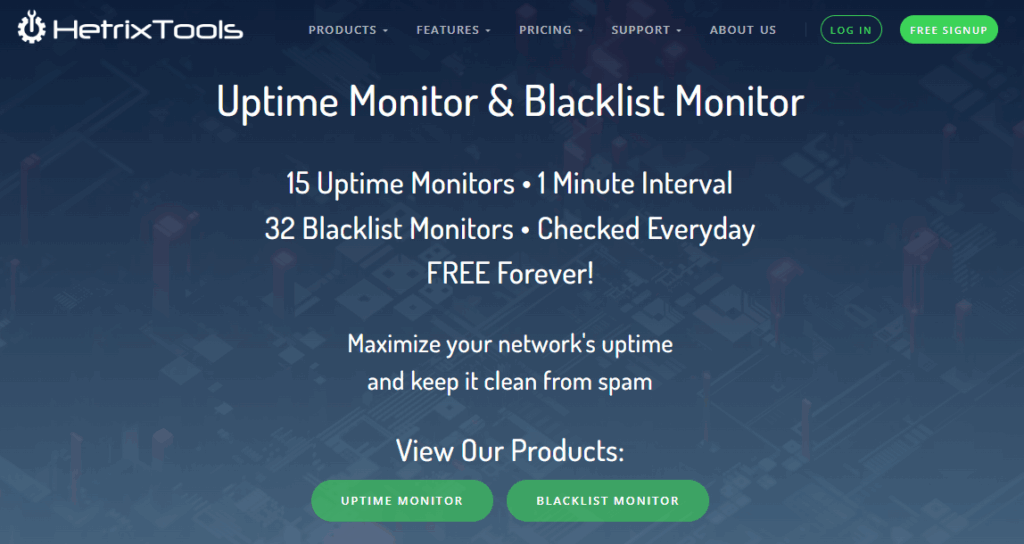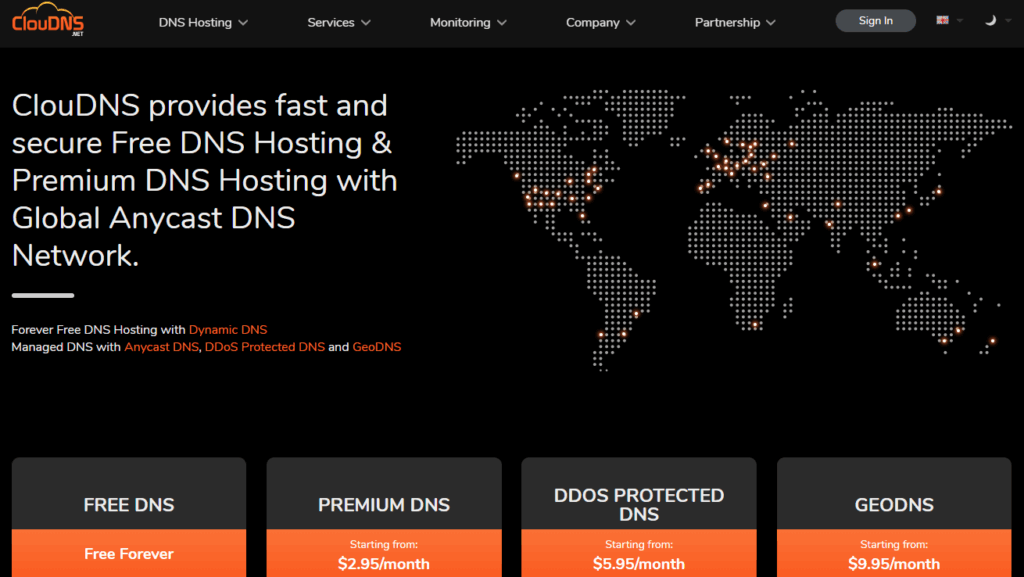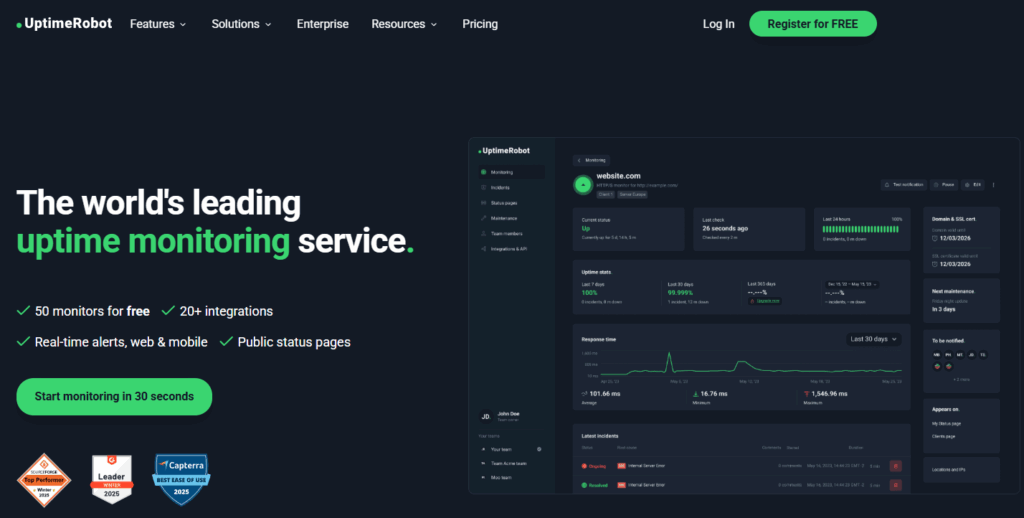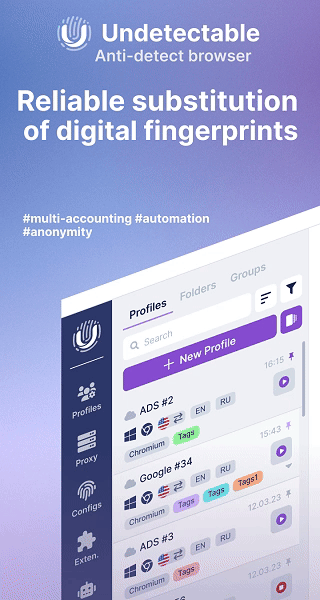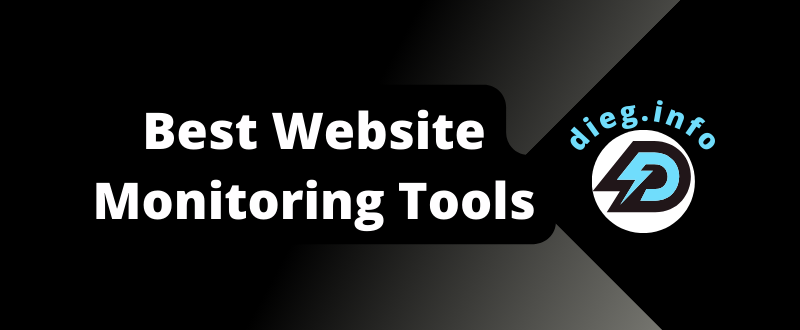
Disclosure: This site may contain affiliate links. If you make a purchase through these links, I may receive a commission at no additional cost to you. However, all opinions are my own.
Website monitoring is an essential part of any modern web resource support. Its purpose is to ensure maximum availability, uninterrupted operation, and rapid response to failures. In practice, monitoring includes checking the website and servers for performance, loading speed, resource status, and notification of problems.
Why is monitoring important?
Monitoring is insurance for website owners. Even a few minutes of downtime can result in lost customers, declining sales, and reduced brand trust.
- 🚨 Quick detection of failures — the service reports the problem immediately, rather than waiting for users to start complaining.
- 💸 Reduced risk of losses — every hour of downtime can mean lost orders or advertising revenue.
- 🔎 Impact on SEO — if a website is frequently unavailable, search engines will lower its ranking, and it will be difficult to regain traffic.
- 📲 Automatic notifications — you will be notified of a failure instantly, even at night or when you are away from the office, and will be able to respond quickly.
- ⚖️ Flexible solutions — you can start with free basic monitoring and switch to professional systems as your project grows.
Minimum requirements for a website monitoring service
A reliable monitoring service should provide a basic set of features without which it is difficult to control the availability and stability of a web resource:
- ⏱️ Check frequency — the ability to run checks at least once a minute for critical services and flexibly configure the interval for tasks.
- 🔍 Check methods — support for HTTP/HTTPS requests, ping, port monitoring, response code analysis, and integration via API.
- 📢 Notifications — instant alerts about failures via email, SMS, push notifications, messengers (e.g., via Telegram bot), or webhooks.
- 📊 Statistics and reports — detailed uptime history, downtime and incident tracking with clear reports.
This basic set allows you to respond quickly to problems and have a transparent picture of the site’s performance.
Advanced requirements:
- 🖥️ Server resource monitoring — control of CPU, RAM, disks, database status, and related services.
- ⚡ Performance — analysis of page load speed and response time under load.
The best services for online website monitoring
Free services are usually sufficient for basic monitoring, but more complex projects will require advanced features: integrations, custom intervals, support for multiple protocols, APIs, team support, and detailed analytics.
1. 🔥 HetrixTools — Server Monitoring and Blacklist Checker
HetrixTools is a cloud service for monitoring website and server availability and checking IP addresses or domains in global blacklist databases (including Spamhaus). It combines uptime monitoring and advanced diagnostics using its own HetrixTools Server Monitoring Agent, allowing you to track server status in real time.
The agent is suitable for VPS, dedicated, and cloud servers, and can even be installed on hosting services without root access—via a special PHP version for cPanel and DirectAdmin. All settings and metric selection are made through the HetrixTools panel, and the collected data can be made private or public as needed.
Pros
- Support for uptime monitoring from different geographic locations.
- Checking domains and IPs in blacklists (spam lists, RBL).
- Automatic diagnostics in case of failures (Ping + MTR from several nodes).
- HetrixTools Agent for Linux and Windows collects system metrics: CPU, RAM, disks, network traffic, service status.
- Ability to monitor specific applications and ports (Nginx, Apache, MySQL, etc.).
Cons
- It is not possible to manually run traceroute from the monitoring panel.
- There is no built-in SLA reporting for customers, as some competitors offer.
💲Pricing
| Plan | Uptime Monitors | Blacklist Monitors | Price/Month | Features |
|---|---|---|---|---|
| Free | 15 | 32 | $0 | All alerts and integrations, basic set of metrics, 1-minute checks, history storage |
| Professional | 30 | 512 | $9.95 | Additional monitors, advanced graphs, extended SLA notifications |
| Business | 60 | 2048 | $19.95 | Even more targets, extended SLAs, advanced analytics |
| Enterprise | 200 | 8192 | $49.95 | Limits for large projects, full functionality, integrations, 2 years of data storage |
- The free plan covers the needs of small websites and VPS, giving full access to most features (with no artificial restrictions except for the number of targets).
- Paid plans are suitable for DevOps, agencies, resellers, and large hosting providers. The cost depends on the number of websites/servers — you can scale without overpaying for unnecessary options.
All plans include:
- Windows/Linux monitoring agent support.
- Alerts via Telegram, Slack, Email, SMS.
- Work with public/private status pages.
- Access to API, detailed history, graphs, and SLA integrations.
2. ClouDNS — Powerful Cloud DNS Hosting with Monitoring
ClouDNS is a universal service for monitoring the availability of websites, servers, and individual services, with additional DNS zone management capabilities. The platform’s advantages include high response speed, convenient configuration, and integration with many types of notifications. In the DNSPerf ranking, it ranks first in terms of speed among its competitors in 2025. Its unique advantage is the global Anycast DNS network with a 10,000% uptime guarantee and free migration of all zones.
SMTP monitoring service!📧🚨 This powerful tool ensures optimal performance of your mail servers by constantly checking mail transactions and server response times. SMTP is essential for sending and receiving emails, and with our new SMTP monitoring service, you will be promptly notified of connection issues, helping you resolve potential problems before they disrupt your communication.
Streaming monitoring service! 🎶🔍 This latest feature from ClouDNS Monitoring, designed specifically for audio, ensures your streams are always available and sound great. It actively checks your audio streams, measures noise levels, and quickly identifies any issues. This proactive approach improves the user experience by minimizing interruptions.
Pros
- SMTP check support — a special tool for monitoring mail servers: provides timely notifications about delays and errors in mail delivery.
- Audio stream monitoring — an exclusive feature for web radio/podcasts: automatic monitoring of availability, noise level, and audio quality.
- Easy addition of new targets (servers, websites, streams) via the control panel, without unnecessary restrictions.
- An additional advantage is integration with powerful DNS: high request processing speed and DDoS protection.
Cons
- Free plan — only 1 target and one week of log storage; for advanced scenarios, you need to upgrade to Premium.
- Some features (Failover, advanced analytics, priority support) are only available in paid plans.
- VPS monitoring only uses Heartbeat technology.
💲Pricing
For a small website or mail server, Free is sufficient, while for businesses or hosting providers, Premium/Enterprise is convenient to use: full incident control and flexible integration with infrastructure.
- Free Monitoring: 1 monitoring check, 7-day log storage, minimum check interval of 10 minutes. Basic notification types included (email, Telegram, SMS).
- Monitoring S ($2.95 per month): 20 checks, 15 days of log storage, minimum interval of 5 minutes. All types of checks and integrations are added. Public status page is allowed. Additional checks — $0.15 per month.
- Monitoring M (most popular, $4.95 per month): 50 checks, 30 days of log storage, minimum interval of 1 minute. All check types included. Additional checks — $0.10 per month.
- Monitoring L ($14.95 per month): 200 checks, 60 days of log storage, minimum interval of 1 minute. All types of checks and notifications included, maximum functionality. Additional checks — $0.08 per month.
24/7 chat support is available for all paid plans.
3. UptimeRobot leads the way in effortless multi-site monitoring
UptimeRobot is one of the most popular cloud services for mass monitoring of websites, servers, and services. Its main advantage is a free plan for 50 monitors and an extremely simple interface, which makes the product ideal for beginners and technical specialists who need to monitor hundreds of resources without unnecessary costs.
UptimeRobot allows you to quickly start monitoring without configuring infrastructure and integrate the solution even into large-scale projects — from blogs to SaaS and cloud services.
Interesting check/monitoring Keyword in UptimeRobot works as follows: The service makes an HTTP(S) request to the specified page and checks whether the response contains a specific word or phrase (keyword). If the word is found (or, conversely, is not found, if you set the check to “does not contain”), the site is considered accessible. If the condition is not met, UptimeRobot will record an error and send a notification.
Basically, Uptimerobot is the way to go if you need to monitor the uptime of a large number of endpoints. It’s simple, inexpensive, and convenient. I recommend using the paid version, as the free version has very limited checking functionality.
Pros
- Simple interface.
- Suitable for beginners.
- DNS monitoring.
Cons
- 5-minute check intervals in the free plan.
- The free version has significantly limited functionality.
- VPS monitoring only uses Heartbeat technology.
💲Pricing
Uptime Robot offers four pricing plans.
- Free: up to 50 monitors, 5-minute interval, basic notifications (email), one public status page.
- Solo: $8/month — 50+ monitors, checks every minute. Up to 10 public status pages. Includes SSL monitor and domain expiration monitoring.
- Team: $34/month — 100+ monitors, more notification channels, advanced features for teamwork.
- Enterprise: from $64/month — custom limits, white-label integrations, SLA, and custom features.
Comparison table of key features of website monitoring services
| Criteria | HetrixTools | ClouDNS | UptimeRobot |
|---|---|---|---|
| Types of checks | Website (HTTP/S), Ping, Port (TCP), SMTP, Heartbeat, Blacklist | HTTP/HTTPS, Ping, TCP, UDP, SMTP, IMAP, Keyword, Heartbeat, SSL/TLS, Streaming | HTTP(s), Keyword, Ping, Port (TCP), Heartbeat. |
| Free plan | Up to 15 monitoring objects (1 min interval), blacklist up to 32 IPs/domains (every day) | 1 monitoring (10 min interval, 7 days history), 1 DNS hosting | Up to 50 sites (5 min interval) |
| Price from | $9.95/month for 30 checks / 1 min interval | $2.95/month for 20 checks / 5-minute interval. | $8/month for 10 checks / 1-minute interval. |
| DNS monitoring | Only control of changes to domain NS servers | Advanced monitoring of DNS queries and servers | Monitoring of various DNS records (A, NS, CNAME, MX, TXT, etc.), notifications of any changes in the DNS zone |
| VPS/VDS monitoring | Yes, by installing the agent on the server or Heartbeat. | Heartbeat | Heartbeat |
| Notifications types | Email, Slack, Telegram, Webhook, SMS | E-mail, Webhooks, Telegram, SMS | Email, SMS, Slack, Telegram, Webhook, Push |
| Status Pages | Public / Private / White-label | Publicly available in paid plans. | Public. Private ones are available in paid plans. |
| Additional features | Blacklist monitoring | Integration with DNS hosting, Failover | Keyword Monitoring |
| API | Yes | Yes | Yes |
| Who it’s for | Webmasters, DevOps, hosting providers, IT professionals | Website owners, DevOps (DNS hosting with Failover) | Universal for websites and services |
| Rating | 8.5 | 7.5 | 7.0 |
HetrixTools is the leader in terms of functionality and price/performance ratio: even with the free plan, you can use professional monitoring tools and receive advanced notifications, which is especially valuable for professionals and businesses. If you need advanced features for free and deep automation, this service is the best choice.
UptimeRobot provides basic features for free, but most professional and additional features are only available on a paid plan.
ClouDNS is the best choice for those looking for premium DNS hosting with integrated monitoring and failover — convenient for owners of large projects and DevOps specialists. ClouDNS Failover works as follows: the service monitors the availability of your main website or server, and if the website/server stops responding, the DNS record is automatically changed to a backup IP so that visitors always reach a working resource. This significantly reduces downtime and allows you to maintain the availability of your web service for users even in the event of failures.
Monitoring Tools: List of Current Tools
Monitoring tools are software or hardware complexes designed to collect data, track performance, identify problems, and alert users to incidents in various systems, such as dedicated servers, VPS/VDS, networks, applications, websites, domains, or even personal computers. These services allow you to track website availability, download speed, service and application performance, as well as errors and failures. Various services, both paid and free, can be used for monitoring. The most popular options include:
- Ping-Admin: monitors website availability around the clock, checks the performance of HTTP, HTTPS, FTP, MySQL, PostgreSQL, POP3, SMTP, IMAP, DNS, Ping, and Telnet.
- Self-hosted SaaS platforms: Premium Self Hosted PHP Scripts – AltumCode: Uptime & Cronjob Monitoring software A personal license costs $79.
- Zabbix is a professional monitoring system that is installed on a VPS/VDS or dedicated server. It helps control the operation of websites, servers, databases, and network equipment. To install it, you will need a server with a web server (Apache or Nginx), a database management system (MySQL or PostgreSQL), and PHP; a minimum of 512 MB of RAM is recommended, with 2 GB or more being optimal. If you need a convenient selection of VPS/VDS for Zabbix, use a special service. Price: free.
- StatusСake. Price from $24.49 per month.
- Uptime Kuma is a self-hosted monitoring tool with a user interface very similar to Uptime Robot. It requires hosting on your own server. There is no built-in support for incident management and collaboration tools.
Conclusion or Quick Selection
Monitoring is the foundation of any stable online project. It helps prevent losses, ensures quick response to outages, and maintains high service quality. The right monitoring tool depends on your project’s scale, specific needs, and budget. No time for testing different services? Sign up for free at HetrixTools.
FAQ 1: What is Heartbeat Monitoring?
Heartbeat Monitoring is a method of monitoring the performance of servers and services based on sending regular “pulsing” signals (heartbeats) from the monitored system to the monitoring service. If these signals stop coming in at a specified interval, the system is considered unavailable or malfunctioning. This approach allows you to track the performance of cron jobs, background processes, applications, and servers that cannot be checked with regular HTTP requests. Heartbeat is particularly effective for monitoring internal services, backups, task queues, and API integrations — the administrator receives instant notifications of failures or delays.
FAQ 2: A practical example of setting up Heartbeat monitoring for cron jobs
A common use case for Heartbeat monitoring is keeping track of critical cron jobs. Without them, essential backend functions of a website or application may become unavailable, yet their failure cannot be detected by standard HTTP monitoring. Heartbeat protects your business from hidden failures — for example, when a price list fails to update, a parser crashes, or notifications stop working, and clients only notice the issues hours or even days later.
Setup in HetrixTools:
- In the HetrixTools dashboard, go to the “Uptime Monitors” section and choose the “Heartbeat Monitor” type.
- Create a new Heartbeat and give it a name.
- Set the Timeout parameter when creating or configuring a Heartbeat monitor. This parameter determines how long a signal can be absent before the task is considered non-functional. For example, if a cron task runs once a day, you should specify 24 hours or slightly more in the Timeout settings; if it runs once a month, the Timeout interval should be set to at least the frequency of the task. Thus, if no signal is received within the specified time, HetrixTools will notify you of a failure.
- The service will generate a unique URL (for example, https://sm.hetrixtools.net/hb/abc123456789).
- At the end of a successful cron script, add the call:
curl -fsS https://sm.hetrixtools.net/hb/your-unique-id>/dev/null - If everything went smoothly during the night, a signal will be sent to HetrixTools.
- If, for any reason, the cron task was not completed (connection error, lack of memory, cron freeze), the heartbeat will not be sent, and you will receive a failure message.

